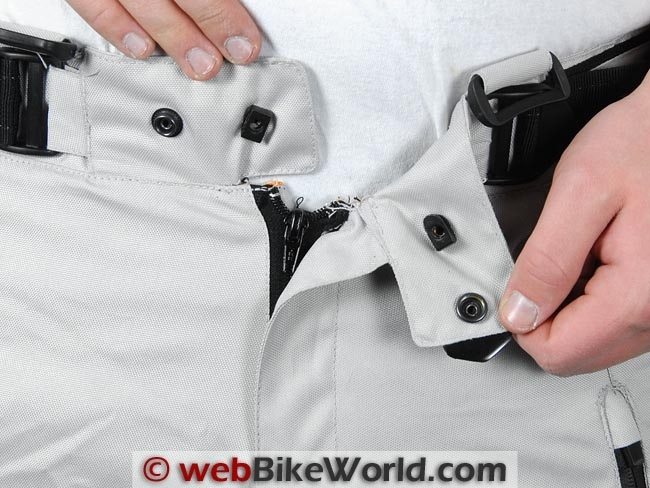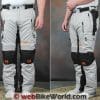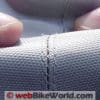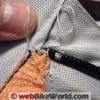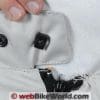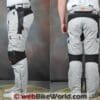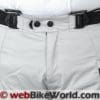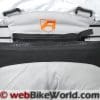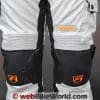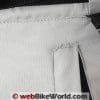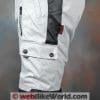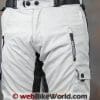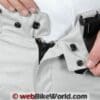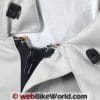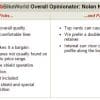The Akito Desert pants pair with the Akito Desert jacket (review) and they can be attached with a waist zipper.
The pants have the same basic quality of construction and stitching as the jacket, with the same issues.
See Part I: Akito Desert Jacket Review
Please refer to Part I of this two-part review, which describes the Akito Desert jacket in detail, with background information on the materials and construction used in the outfit.
The Desert pants are very inexpensive with a street price of around $135.00.
The jacket and pants have a long list of features and various acronyms and buzzwords included on the hang tags.
But the overall construction quality, quality of the materials and the stitching of both the jacket and pants is not up to the standards we’ve seen in other motorcycle clothing.
So while the Desert outfit looks the part and it will keep the wearer reasonably warm and dry, there are better clothing values available, even if they do cost a bit more. It just doesn’t make sense to get something at the lowest price, only to find that it doesn’t perform to a reasonable standard.
The techniques and science behind the construction of a motorcycle garment is very important. Unfortunately, many of these techniques are subtle and not always recognized by the consumer.
Even though a jacket “looks like a motorcycle jacket” and a pair of pants “looks like a pair of motorcycle pants” to the casual observer, the material types, construction techniques, seaming and stitching are what make the difference in a quality garment and it’s why better-made clothing costs more.
This has been discussed time and again in the webBikeWorld reviews, but unfortunately many motorcyclists still look at the price tag first, thinking that everything is equal (“a jacket is a jacket”), thus a low price is better.
Serious and experienced riders, however, usually know the difference and they first consider the quality and protective features to determine if the price is justified.
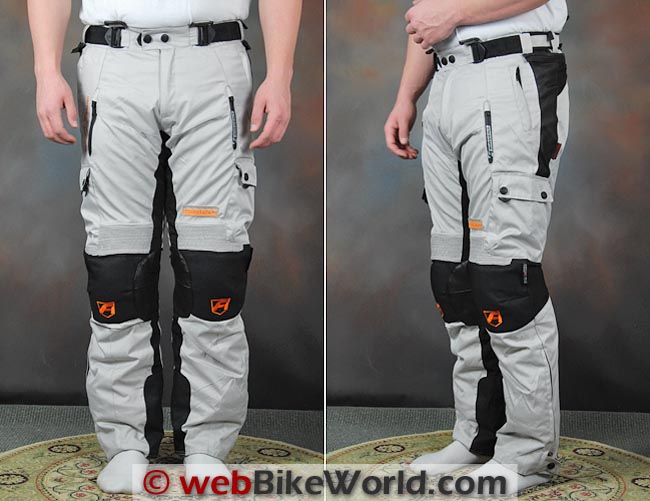

Akito Desert Pants – Outer Shell
The Desert pants are made from the same type of (claimed) 600 denier polyester material as the Desert jacket. The fabric is relatively soft and, when observed in close detail, it has what appears to be a looser weave than other types of shell fabrics we’ve seen.
The softer fabric is comfortable, however, with none of the canvas-like stiffness found in many other jackets and pants. But that stiffness is usually a sign of a “hard” fabric that is designed to suffer both the initial impact burst and secondary abrasion resistance.
The Desert pants also use the same questionable construction techniques as the Desert jacket. Most of the sections are connected with single-row external stitching, which is a less complex and less expensive method compared to folded and/or hidden seams, double or triple (or more) rows of internal or external stitching and multiple layers of abrasion-resistant fabric.
The stitching on the pants is horrendous, quite frankly. Be sure to see the slide show included below, which has some close-up details of the stitching, with loose ends hanging on many seams. I can literally pull the fabric apart at some of the seams, and this is unacceptable in a motorcycle garment that is designed primarily to protect the wearer.
The black sections of fabric visible in the photos of our Desert pants differ from the light gray material. The black fabric is a finer weave and appears to be some sort of basic polyester shell material similar to what one might find on a casual windbreaker type of jacket.
The exception is the black fabric covering the front of the knees, which has a thicker weave than the pants shell and appears to be a type of abrasion-resistant fabric. The pants also feature strips of perforated leather along the outer thighs and inside the legs at the knees.
The pants are lined with the same very thin mesh material found in the Desert jacket. The outer shell material and mesh liner is so thin that a flashlight easily shines through both layers, and this puts doubts in my mind as to the ability of the fabric to resist abrasion if called upon to do so.
The crotch of the Desert pants is covered with a rubbery sort of textured material, which provides good traction when sitting on a motorcycle saddle.
The vertical seam up the rear of the pants is where the two halves of material meet. It has a single row of stitching on either side and I can pull on both halves of the material to easily stretch the seam apart. It probably wouldn’t take much more effort for me to rip the pants in two at this seam, and this indicates a rather frightening level of quality with regards to the construction.
I would not want to fall off a motorcycle and go sliding down the road wearing these pants — sorry! In fact, even motorcycle jeans have reinforced seams where the sections of fabric are joined.
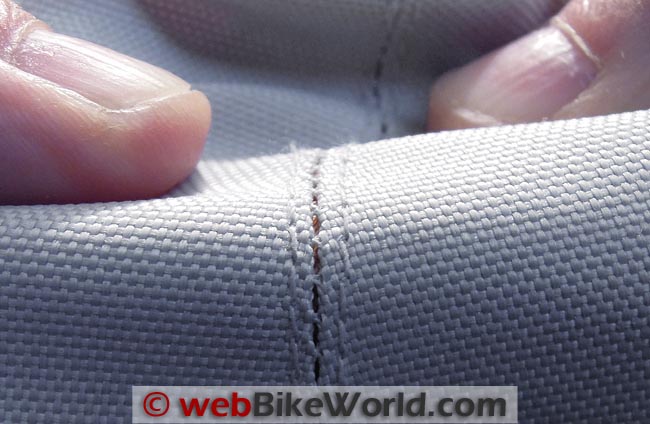


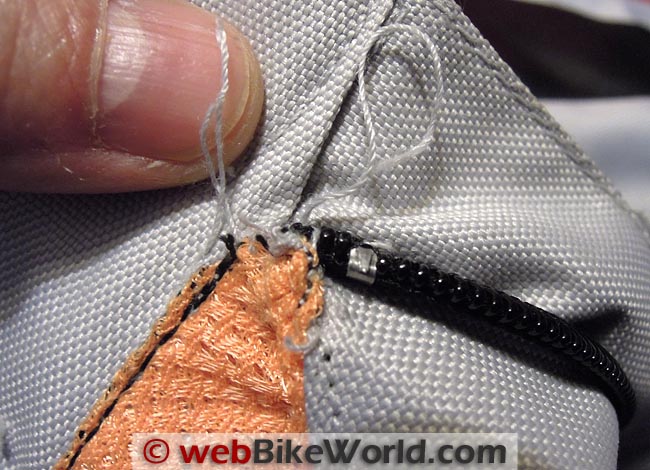


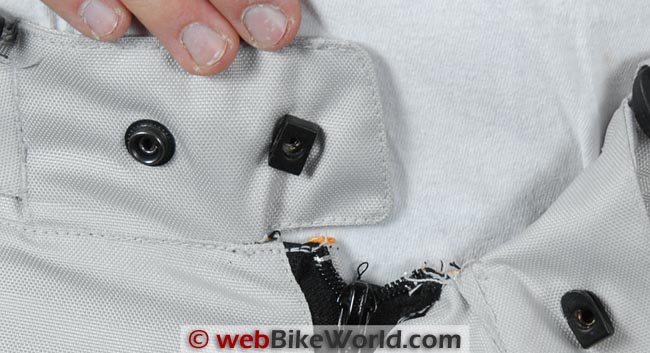


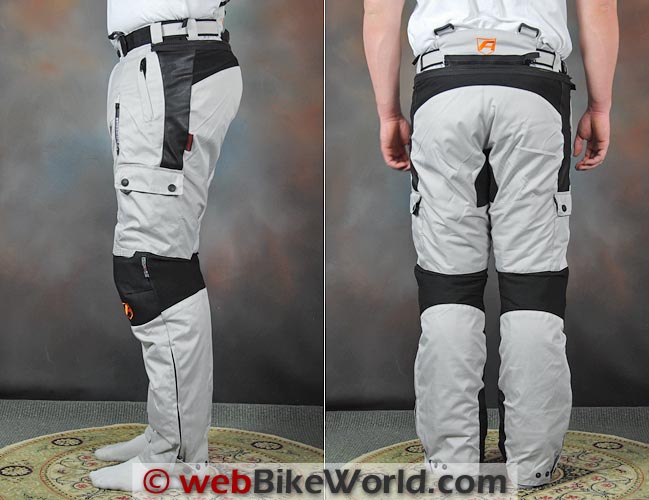

Waist and Adjusters
The Desert pants have a YKK-labeled zipper fly. The fly is backed by a gusset of the outer shell fabric. The waist secures with a tab that has two rubberized snap covers; one is a snap and the other is a metal hook. The use of a hook is commendable, but the snap and hook are riveted directly through the lightweight shell material without any other reinforcements.
A waist adjuster is included at each side of the pants. This consists of a fabric belt that continues around the rear of the waist. The belt acts as a cinch to adjust the waist, and the loose end must be tucked under the belt loop on the side, but if the waist isn’t cinched far enough, the belt end simply hangs loose on the side of the pants because there is no hook-and-loop to secure it.
The pants also have two plastic square D-rings in the front and rear, which could be used for some type of fabric suspenders, but there were no suspenders included with our outfit.
Akito Desert Pants Pockets
The Desert pants shell features vertical hand pockets on either side. The pockets are lined with a water-resistant material and they use YKK labeled zippers, although the zippers are not of the water-resistant type.
A cargo pocket is located on each leg at the outer thigh. These pockets have a folded-over flap that secures with metal snaps and the snaps have a rubberized external backing. The pockets measure approximately 16 cm by 18 cm (6.5″ x 7″).
Ventilation
The material used for both the jacket and pants shells has some breathability, due to the weave. This provides some “natural” ventilation through air seepage or flow through the fabric.
The pants have a vertical vent on either side, just inboard of the pockets. These vents are covered with water-resistant zippers, one of which reads “Airvent” and the other is unlabeled. The vents don’t really add much ventilation, as they are pointed upwards when the rider is seated and there’s not much air flow over that area anyway when riding a motorcycle.
Leg Cuffs
The Desert pants have a long 30 cm (12″) non-locking zipper along the outside, starting at the leg cuff. The cuffs have a two-position snap adjustment
Thermal and Water-Resistant Pants Liners
The Desert pants have the same dual liner system found on the Desert jacket. An internal orange-colored thermal liner is very thin, with a thin layer of some type of lining sewn between.
The outer liner is a (claimed) water-resistant, wind-resistant and breathable liner of a type and construction similar to the liner used in the jacket. The liners connect to the pants shell with full-length zippers along the top and, surprisingly, zippers at the bottom in the leg cuff. This is a preferred method of attaching pants liners because it keeps them in place when the rider is putting the pants on or taking them off.
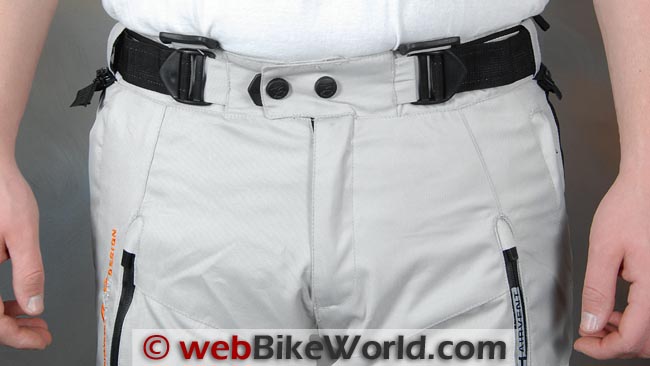

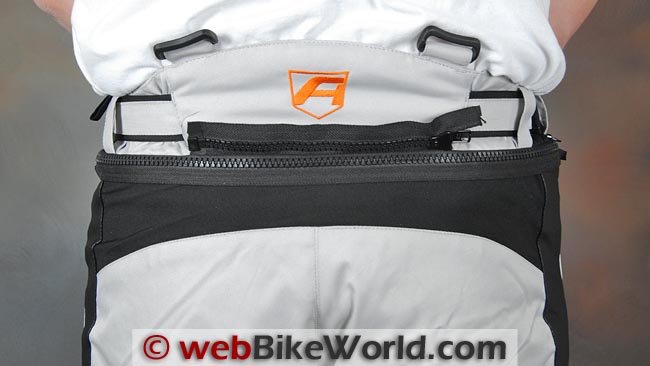

Safety, Armor and Protection
Akito lists Knox armor for the Desert pants, but like our Desert jacket, the knee protectors are unlabeled, unlike any other Knox armor we’ve seen.
The protectors are held in a pocket formed of the thin liner material. There are three rows of hook-and-loop which appear to allow some vertical adjustment for the protectors if needed. No additional padding or armor included in the Desert pants.
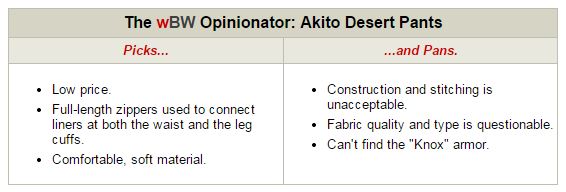


Conclusion
The Akito Desert pants are proof that low price isn’t everything. There just isn’t much here to recommend and for me, the quality level of these pants is unacceptable and does not meet my personal criteria for motorcycle clothing.
Part I: Akito Desert Jacket Review
Owner Comments and Feedback
See details on submitting comments.


